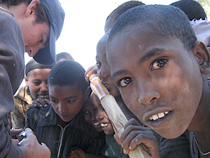
The primary focus of the Margolis laboratory is research on the cellular and molecular mechanisms that regulate the establishment and maintenance of latent neuronal infection with herpes simplex virus (HSV). Ongoing research is aimed at documenting the role of both neuronal and viral gene expression in the establishment and maintenance of HSV latency. The ultimate goal of this work is to gain enough of an understanding about the regulation of HSV latent infection that therapeutic interventions can be devised to eliminate latent infection or prevent viral reactivation. A second line of investigation focuses on development and evaluation of molecular diagnostics for infectious eye disease. A third line of investigation focuses on the use of telemedicine to screen AIDS patients for CMV retinitis in developing countries. |
Establishment of Latent Infection with Herpes Simplex Virus
T.P. Margolis, N. Giordani, A. Bertke, A. Ma, M Margolis, Ali Zhadmehr
The primary focus of this laboratory is to carry out research on the viral and cellular mechanisms that regulate the establishment and maintenance of latent neuronal infection with herpes simplex virus (HSV-1). Previous work suggests that establishment and maintenance of HSV latent infection is heavily dependent on the genetic expression of the host neuron. Ongoing research is aimed at documenting the role of both viral and neuronal gene expression in the establishment and maintenance of HSV latency. This is being accomplished through a number of different basic strategies. The first strategy is to test the effect of host candidate genes on the outcome of infection with HSV. A second strategy has been to develop an in vitro system for studying both productive and quiescent (latent) infection of neurons.. Through this system we have also discovered that two key viral regulatory genes, ICP27 and ICP22, which are required for productive HSV-1 infection of replicating cells, do just the opposite in neurons. They promote the establishment of a latent infection. This is a key finding which suggest that expression of these two genes plays a key role in regulating HSV latent infection and reactivation. A third strategy has been to examine why HSV-1 and HSV-2 preferentially establish latent infection in different subsets of ganglionic neurons. Through the use of HSV-1/HSV-2 intertypic recombinants we have found that a fragment of the viral LAT in HSV-2 clearly dictates specificity for preferential productive viral infection in A5+ neurons and latent infection in KH10+ neurons. A major focus of current research is to use our in vitro system to study the molecular mechanisms by which this cis acting mechanism regulates both the differential permissiveness of A5+ and KH10+ neurons for productive infection in vitro as well as the establishment of latent infection in vivo. The ultimate goal of our work on HSV is to gain enough of an understanding about the regulation of latent infection that therapeutic interventions can be devised to eliminate latent infection or prevent viral reactivation.
T.P. Margolis, A.V. Cevallos, C. Liu
In the past we developed molecular assays to aid in the diagnosis of HSV1, HSV6, HSV7, VzV, CMV, toxoplasmosis eye diseases and have moved these assays into the clinical laboratory at the Proctor Foundation. We are currently using molecular diagnostics to help determine the cause of SHAPU, a seasonal panuveitis of children in Nepal. We have recently revaluated optimal conditions for detecting VzV in corneal samples and for acanthamoeba keratitis.
Telemedicine for CMV Retinitis
J. Keenan, J. Chen, E. Walker, A. Skalet, S. Ausayakhun, G. Holland, D Heiden, C. Jirawison, R. Maamri, C. Khouri, D. Fletcher, and T.P. Margolis
Cytomegalovirus (CMV) retinitis is a treatable infection of the retina affecting AIDS patients, and is a leading cause of blindness in many developing countries. There are currently 33.2 million people living with HIV worldwide, with the most severely affected regions being Sub-Saharan Africa, Southeast Asia and India. In many of these countries, intensive national and international efforts have led to the development of programs for HIV diagnosis and treatment. However, most of these programs have no systems in place for screening patients for CMV disease. In collaboration with investigators at Chiang Mai University Medical Center in Thailand we have begun investigating the feasibility of using telemedicine as a means of diagnosing CMV retinitis. At a tertiary care center we found that remote readers had about 90% sensitivity and 88% specificity in diagnosing CMV retinitis as compared to examining retinal specialists. We also found that patients presenting to the eye clinic in Chiang Mai had much more advanced, active disease, including a very high prevalence of bilateral eye disease and frosted branch angiitis at the time of their presentation as compared to what is seen in developed countries. We currently have ongoing studies looking at the prevalence of CMV retinitis in a primary care HIV clinic at Nakornping Hospital as well as the efficacy of using telemedicine to screen for CMV retinitis in this primary care setting. Patient recruitment is complete and we are now evaluating the data.  We are also evaluating the ability of non-medical professionals in both the US and Thailand to evaluate the digital fundus photos. Finally, we have completed constructing and initial testing of a very low cost cellphone based camera to be used by non-Ophthalmologist to photograph the retina to screen for CMV retinitis. This camera is also being evaluated for its ability to screen patients for diabetic retinopathy, glaucoma, macular degeneration, emergency room care and retinopathy of prematurity.
We are also evaluating the ability of non-medical professionals in both the US and Thailand to evaluate the digital fundus photos. Finally, we have completed constructing and initial testing of a very low cost cellphone based camera to be used by non-Ophthalmologist to photograph the retina to screen for CMV retinitis. This camera is also being evaluated for its ability to screen patients for diabetic retinopathy, glaucoma, macular degeneration, emergency room care and retinopathy of prematurity.
If successful we hope to place the job of take screening for CMV retinitis into the hands of HIV care providers. In establishing telemedicine screening centers we believe that will we be able to provide improved care for more individuals as well as establish a network of centers for future studies on the most cost-effective ways of managing CMV retinitis in patients that are initiating HAART. Our long-term goals at this point include the further development and testing of 1) lower cost devices for imaging the retina and 2) artificial intelligence systems for diagnosing CMV retinitis without the need of a highly trained ophthalmologist.
Margolis Lab Personnel
 Nicole Giordani, PhD Postdoctoral Fellow |
 Josephine Gesulga Laboratory Assistant |
 Aye Aye Ma Research Associate |

